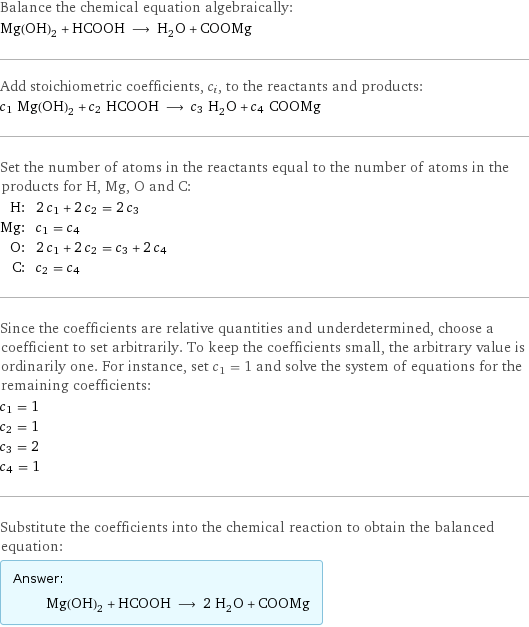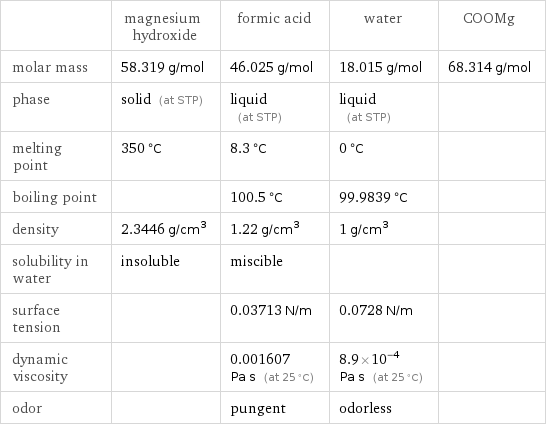Input interpretation

Mg(OH)_2 magnesium hydroxide + HCOOH formic acid ⟶ H_2O water + COOMg
Balanced equation

Balance the chemical equation algebraically: Mg(OH)_2 + HCOOH ⟶ H_2O + COOMg Add stoichiometric coefficients, c_i, to the reactants and products: c_1 Mg(OH)_2 + c_2 HCOOH ⟶ c_3 H_2O + c_4 COOMg Set the number of atoms in the reactants equal to the number of atoms in the products for H, Mg, O and C: H: | 2 c_1 + 2 c_2 = 2 c_3 Mg: | c_1 = c_4 O: | 2 c_1 + 2 c_2 = c_3 + 2 c_4 C: | c_2 = c_4 Since the coefficients are relative quantities and underdetermined, choose a coefficient to set arbitrarily. To keep the coefficients small, the arbitrary value is ordinarily one. For instance, set c_1 = 1 and solve the system of equations for the remaining coefficients: c_1 = 1 c_2 = 1 c_3 = 2 c_4 = 1 Substitute the coefficients into the chemical reaction to obtain the balanced equation: Answer: | | Mg(OH)_2 + HCOOH ⟶ 2 H_2O + COOMg
Structures

+ ⟶ + COOMg
Names

magnesium hydroxide + formic acid ⟶ water + COOMg
Equilibrium constant
![Construct the equilibrium constant, K, expression for: Mg(OH)_2 + HCOOH ⟶ H_2O + COOMg Plan: • Balance the chemical equation. • Determine the stoichiometric numbers. • Assemble the activity expression for each chemical species. • Use the activity expressions to build the equilibrium constant expression. Write the balanced chemical equation: Mg(OH)_2 + HCOOH ⟶ 2 H_2O + COOMg Assign stoichiometric numbers, ν_i, using the stoichiometric coefficients, c_i, from the balanced chemical equation in the following manner: ν_i = -c_i for reactants and ν_i = c_i for products: chemical species | c_i | ν_i Mg(OH)_2 | 1 | -1 HCOOH | 1 | -1 H_2O | 2 | 2 COOMg | 1 | 1 Assemble the activity expressions accounting for the state of matter and ν_i: chemical species | c_i | ν_i | activity expression Mg(OH)_2 | 1 | -1 | ([Mg(OH)2])^(-1) HCOOH | 1 | -1 | ([HCOOH])^(-1) H_2O | 2 | 2 | ([H2O])^2 COOMg | 1 | 1 | [COOMg] The equilibrium constant symbol in the concentration basis is: K_c Mulitply the activity expressions to arrive at the K_c expression: Answer: | | K_c = ([Mg(OH)2])^(-1) ([HCOOH])^(-1) ([H2O])^2 [COOMg] = (([H2O])^2 [COOMg])/([Mg(OH)2] [HCOOH])](../image_source/d3f7e212c9dc03fce58fcd1991272fb5.png)
Construct the equilibrium constant, K, expression for: Mg(OH)_2 + HCOOH ⟶ H_2O + COOMg Plan: • Balance the chemical equation. • Determine the stoichiometric numbers. • Assemble the activity expression for each chemical species. • Use the activity expressions to build the equilibrium constant expression. Write the balanced chemical equation: Mg(OH)_2 + HCOOH ⟶ 2 H_2O + COOMg Assign stoichiometric numbers, ν_i, using the stoichiometric coefficients, c_i, from the balanced chemical equation in the following manner: ν_i = -c_i for reactants and ν_i = c_i for products: chemical species | c_i | ν_i Mg(OH)_2 | 1 | -1 HCOOH | 1 | -1 H_2O | 2 | 2 COOMg | 1 | 1 Assemble the activity expressions accounting for the state of matter and ν_i: chemical species | c_i | ν_i | activity expression Mg(OH)_2 | 1 | -1 | ([Mg(OH)2])^(-1) HCOOH | 1 | -1 | ([HCOOH])^(-1) H_2O | 2 | 2 | ([H2O])^2 COOMg | 1 | 1 | [COOMg] The equilibrium constant symbol in the concentration basis is: K_c Mulitply the activity expressions to arrive at the K_c expression: Answer: | | K_c = ([Mg(OH)2])^(-1) ([HCOOH])^(-1) ([H2O])^2 [COOMg] = (([H2O])^2 [COOMg])/([Mg(OH)2] [HCOOH])
Rate of reaction
![Construct the rate of reaction expression for: Mg(OH)_2 + HCOOH ⟶ H_2O + COOMg Plan: • Balance the chemical equation. • Determine the stoichiometric numbers. • Assemble the rate term for each chemical species. • Write the rate of reaction expression. Write the balanced chemical equation: Mg(OH)_2 + HCOOH ⟶ 2 H_2O + COOMg Assign stoichiometric numbers, ν_i, using the stoichiometric coefficients, c_i, from the balanced chemical equation in the following manner: ν_i = -c_i for reactants and ν_i = c_i for products: chemical species | c_i | ν_i Mg(OH)_2 | 1 | -1 HCOOH | 1 | -1 H_2O | 2 | 2 COOMg | 1 | 1 The rate term for each chemical species, B_i, is 1/ν_i(Δ[B_i])/(Δt) where [B_i] is the amount concentration and t is time: chemical species | c_i | ν_i | rate term Mg(OH)_2 | 1 | -1 | -(Δ[Mg(OH)2])/(Δt) HCOOH | 1 | -1 | -(Δ[HCOOH])/(Δt) H_2O | 2 | 2 | 1/2 (Δ[H2O])/(Δt) COOMg | 1 | 1 | (Δ[COOMg])/(Δt) (for infinitesimal rate of change, replace Δ with d) Set the rate terms equal to each other to arrive at the rate expression: Answer: | | rate = -(Δ[Mg(OH)2])/(Δt) = -(Δ[HCOOH])/(Δt) = 1/2 (Δ[H2O])/(Δt) = (Δ[COOMg])/(Δt) (assuming constant volume and no accumulation of intermediates or side products)](../image_source/975d6dab99d620dea46691e80f824725.png)
Construct the rate of reaction expression for: Mg(OH)_2 + HCOOH ⟶ H_2O + COOMg Plan: • Balance the chemical equation. • Determine the stoichiometric numbers. • Assemble the rate term for each chemical species. • Write the rate of reaction expression. Write the balanced chemical equation: Mg(OH)_2 + HCOOH ⟶ 2 H_2O + COOMg Assign stoichiometric numbers, ν_i, using the stoichiometric coefficients, c_i, from the balanced chemical equation in the following manner: ν_i = -c_i for reactants and ν_i = c_i for products: chemical species | c_i | ν_i Mg(OH)_2 | 1 | -1 HCOOH | 1 | -1 H_2O | 2 | 2 COOMg | 1 | 1 The rate term for each chemical species, B_i, is 1/ν_i(Δ[B_i])/(Δt) where [B_i] is the amount concentration and t is time: chemical species | c_i | ν_i | rate term Mg(OH)_2 | 1 | -1 | -(Δ[Mg(OH)2])/(Δt) HCOOH | 1 | -1 | -(Δ[HCOOH])/(Δt) H_2O | 2 | 2 | 1/2 (Δ[H2O])/(Δt) COOMg | 1 | 1 | (Δ[COOMg])/(Δt) (for infinitesimal rate of change, replace Δ with d) Set the rate terms equal to each other to arrive at the rate expression: Answer: | | rate = -(Δ[Mg(OH)2])/(Δt) = -(Δ[HCOOH])/(Δt) = 1/2 (Δ[H2O])/(Δt) = (Δ[COOMg])/(Δt) (assuming constant volume and no accumulation of intermediates or side products)
Chemical names and formulas

| magnesium hydroxide | formic acid | water | COOMg formula | Mg(OH)_2 | HCOOH | H_2O | COOMg Hill formula | H_2MgO_2 | CH_2O_2 | H_2O | CMgO2 name | magnesium hydroxide | formic acid | water | IUPAC name | magnesium dihydroxide | formic acid | water |
Substance properties

| magnesium hydroxide | formic acid | water | COOMg molar mass | 58.319 g/mol | 46.025 g/mol | 18.015 g/mol | 68.314 g/mol phase | solid (at STP) | liquid (at STP) | liquid (at STP) | melting point | 350 °C | 8.3 °C | 0 °C | boiling point | | 100.5 °C | 99.9839 °C | density | 2.3446 g/cm^3 | 1.22 g/cm^3 | 1 g/cm^3 | solubility in water | insoluble | miscible | | surface tension | | 0.03713 N/m | 0.0728 N/m | dynamic viscosity | | 0.001607 Pa s (at 25 °C) | 8.9×10^-4 Pa s (at 25 °C) | odor | | pungent | odorless |
Units
